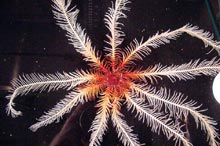
This colorful crinoid is just one of the many interesting creatures we collect every day. Photo by Jerry McLelland, University of Southern Mississippi. Click image for larger view.
Maiden Voyages: Two Memoirs
August 14, 2003
Frank Helies
Dara Hooker
Graduate Students
University of South Carolina
Lessons For First Timers
Frank Helies
Fair skies, calm seas, and good luck. Every sailor’s wish. Then bang: torrential downpours, waves that would make professional surfers tremble, seasickness, malfunctioning equipment, uncooperative oceanographic phenomena, Betty’s spastic swordfish, and the pipe dredge. Of course there are the sunsets, the crystal blue water, the 385 stars and two planets you can see with the naked eye on a clear night, the porpoises, the flying fish, and the myriad assortment of benthic and pelagic critters. The bad with the good, hand in hand. But first, the preparation, the anticipation, the questions.
First timers: We the select few who get to join the ranks of experienced explorers for a first go-around. Hundreds of questions pass through our minds prior to departure. What to take? Will it storm? Will I get sick? Can I survive the 6-hr shifts? What will we find? What will I learn? The possibilities are endless.
There are a few things to keep in mind when dealing with first timers. For one, first timers are never wrong but seldom right. Instructions may need to be given multiple times. If this causes one to become green in the face, they are probably just ill. Simply direct them to the nearest rail and prepare for projectile vomiting. Most first timers are filled with curiosity as well as confusion. If you find one walking around aimlessly or staring at a large winch, direction may be required. Along those same lines, if it is a question of the green or blue hose, don’t waste your time; consult a crew member.
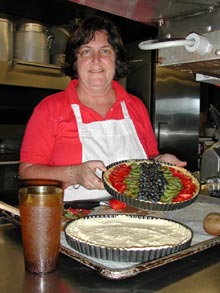
After two weeks of sedentary living and eating Judy’s amazing cooking, everyone aboard the R/V Seward Johnson will leave a few pounds heavier. Click image for larger view.
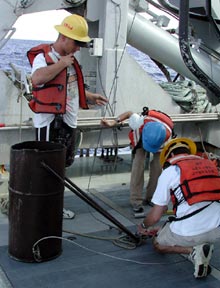
When working on deck, the science party and crew are required to wear hard hats and life vests Click image for larger view.
Now to some of the particulars. The first two days or so should be used as an adjustment period. Quickly finding your daily routine on the ship will ease your transition into life at sea. You will determine that meal time is priority number one, particularly because the food is borderline gourmet. Prime rib, salmon, crab legs, pizza and the almond green beans are particularly delectable. You will discover that there are innumerable ways to prepare meatloaf, including, in addition to the actual loaf, meatloaf cheeseburgers and meatloaf pita sandwiches, all of which are delicious. You will learn how to sleep from noon to six or six to midnight and enjoy it. After a while, sleeping with three other people below deck in what feels like a washing machine stuck on extra rinse will not require earplugs, but possibly headphones and a good B.B. King album.
You will determine how many cups of coffee and Butterfingers are required to survive the graveyard shift. You will get to know the captain (who loves dogs and tolerates cats), crew, educators and scientists, and really enjoy their company, although living in close quarters for 2 wks will reveal each individual’s quirks. Well aware of how frequently scientists work out, you will inquire about an exercise room and the chief scientist will tell you tall tales of lost colleagues and "the curse of the pink 5-lb free weight."
You will learn the difference between a salp, a jellyfish, a sea squirt and a floating piece of silicon caulk. You will realize that you have the opportunity to travel 1,600 ft below the surface in a battery-operated Plexiglas sphere and somehow feel safe despite it not being an amusement ride in The Living Seas at Orlando's Epcot Center. You will wear the life vest and hard hat while working on deck, no matter how silly or uncomfortable you feel, especially during the night shift, as you deploy the pipe dredge in 40-knot winds. You will truly appreciate the professionals who cruise 300 days a year and feel relieved that you can take your data to the safety of a lab where the equipment does not need to be lashed down. Most of all, you will have fun.
It may be the only trip you make to sea or there may be many more to come. Either way, your first research cruise will be among the ones you remember most.
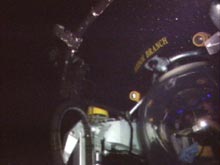
Dara Hooker descended deep below the photic zone on her first dive in the Johnson-Sea-Link II submersible. Click image for larger view.
There and Back Again
Dara Hooker
When I was told that I would get to come on this cruise, I was ecstatic. There are so many reasons to feel blessed. After all, I get to be on the ocean for 2 wks, meet new people and make new friends. I will start graduate school in a couple of weeks already equipped with the data set for my thesis, which is very nice. What I was most excited about by far, though, was the prospect of going down to the ocean floor in the submersible, and, in fact, I took my turn in the front sphere. It was the fulfillment of a dearly held dream.
The sub dive was the most incredible thing I’ve ever experienced. The front sphere is made of 5-in-thick Plexiglas. It’s a cramped space even for a small person, but once you’re in the water, the Plexiglas makes it hard to tell where the sub ends and the water begins. This gives the impression of more space. You can see much of what’s around you. There are lots of instruments overhead, behind and to either side of you, but when you’re sitting underneath more than 1,800 ft. of ocean, that’s only vaguely comforting.
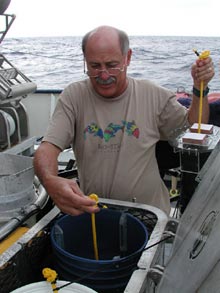
Co-chief Scientist Steve Stancyk from the University of South Carolina prepares the clod cards for deployment. The sub pilot will use the manipulator arm to place them at various locations on the sea floor. Click image for larger view.
It’s a beautiful thing and also a little daunting, saying goodbye to the sun as you sink deep down past the photic zone. I watched with awe as the light faded and died while unknown silvery objects darted past us. We were treated to the passage of a school of pretty squid directly in front of us on the way down. It took everything I had to maintain my composure and not squeak with delight at each amazing new thing I saw. At that depth, it’s cold and dark, yet still teeming with life, an elegant and exotic world.
Going down in the sub is not a sightseeing trip, however; there are measurements to be recorded and samples, both biological and geological, to be collected at short intervals. I saw many lovely creatures, but the most astounding thing I saw was a series of ascending ledges that looked just like part of an ancient, underwater amphitheater. I swear, it almost didn’t look natural! My professor, Rich Styles, who was in the back part of the sub, dubbed the location Neptune’s Staircase, which is exactly what it looked like.
One of the primary goals for our dive was the deployment and retrieval of a set of clod cards on at least two sites, one raised and one depressed. We hoped to use the cards to measure microcurrents in different locations on the sea floor. It was a tough job getting the clod card deployment units out of the bucket intact. Craig Caddigan, the sub pilot in control of the mechanical arm, came through for us in a big way. We did manage to deploy two of the three units we brought down with us in good locations. The best part is that after a few days of inclement weather, we were able to return to the deployment sites and retrieve them. Now it’s just a matter of waiting until we get back to shore to examine the cards and see what information we can glean from them.
























